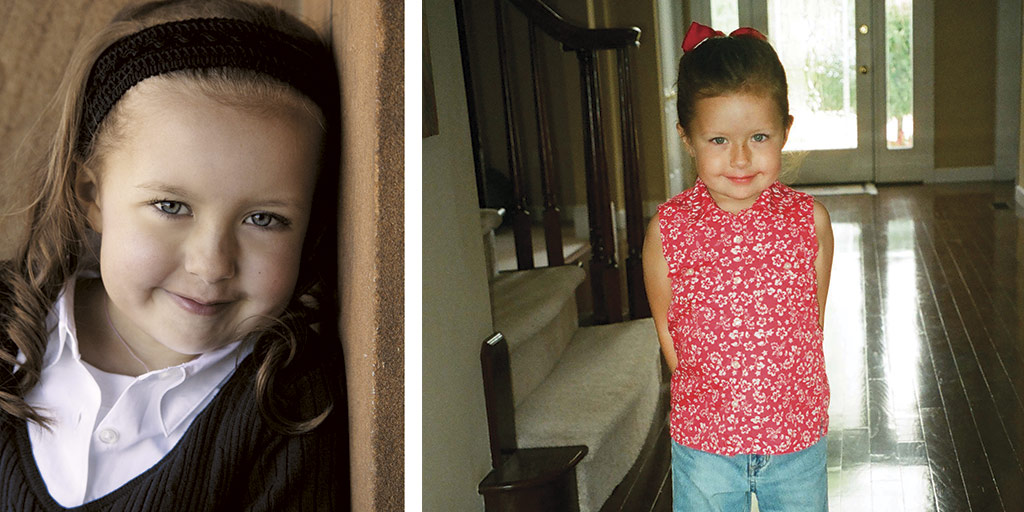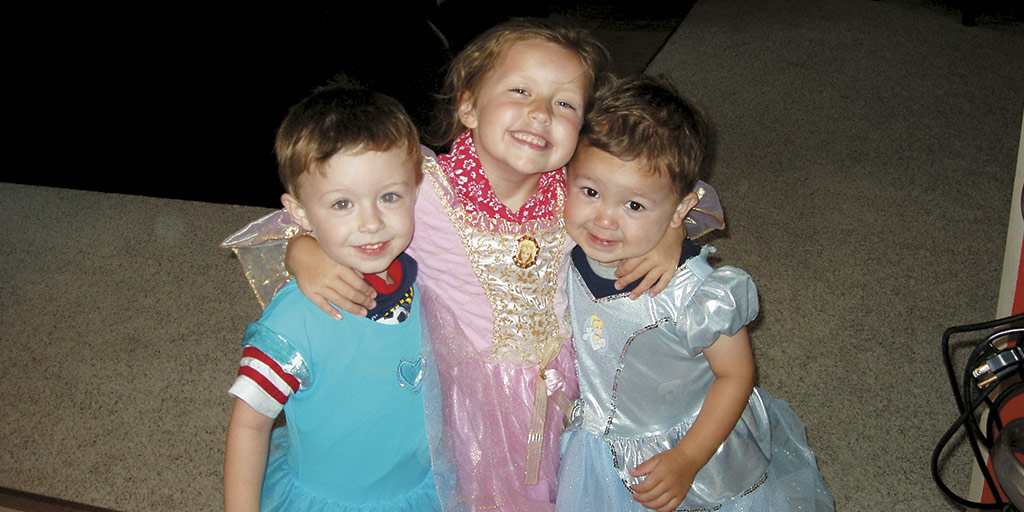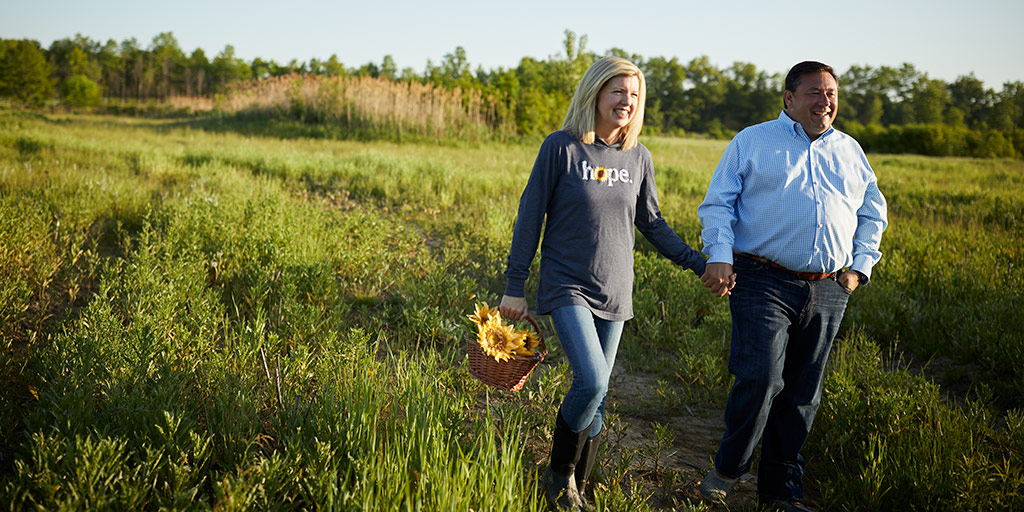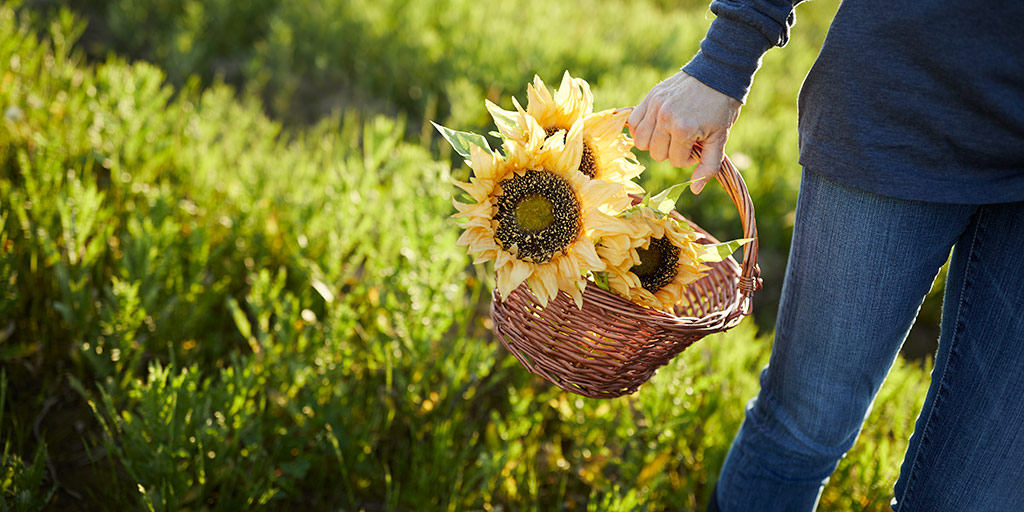Flower Child
by Ken Schneck | Jul. 11, 2018 | 12:00 PM

PHOTOGRAPHED BY JEFF DOWNIE
Megan and Ed McNamara sit on a bench built into a raised, wooden deck overlooking an empty field. Nestled up against Interstate 90 in Avon, the knee-high grasses and weeds grow in spotty rows.
It’s early June. But in a few weeks, the McNamaras will be busy, coordinating volunteers and working with a local farmer to plant the 25 acres with sunflowers, which bloom into a sea of happy yellow in September.
As the gray sky starts to gently rain down, Megan opens her umbrella decorated with a large sunflower. She sighs, not at the weather, but at the circumstance.
This field, Maria’s Field of Hope, bears her daughter’s name and commemorates children touched by pediatric cancer. Maria died when she was just 7 years old from a type of brain cancer known as diffuse intrinsic pontine glioma. Since the field was first planted in 2014, this ground has been a destination for tens of thousands of visitors who have pulled off to the side of the road to remember those who have died, celebrate those who have survived and pause to think about all the lives affected by the disease.
The sounds of the cars whizzing by on the highway a few yards away are drowned out by the rumble of construction: a bulldozer destroying the ground in front of it, a dump truck unloading gravel and the high-pitched beep warning of the equipment’s every movement.
Although the couple has sat in this field hundreds of times, this is dramatically different. The machinery tearing up the ground has its steel sights set on the field of sunflowers, making 2018 almost certainly the last time they’ll bloom here.
“It’s depressing,” says Megan. “This field has meant so much to so many people. Watching it get plowed under is just hard to watch.”
Maria Caroline McNamara was born Jan. 11, 2000. She was the first child for Megan and Ed, who met during their junior year of high school at Magnificat and St. Ignatius.
Maria’s sunny disposition shined for all to see. She loved connect-the-dot books and absolutely adored her ballet and jazz classes at Emjaez Dance Studio in Bay Village.
By 6, she cherished her big sister role to brothers Eddie, Aidan and Blake, regularly suggesting activities from miniature golf to dressing them up in costumes.
“Her brothers looked up to her as a leader of the family,” Ed says. “They learned so much from her about how to laugh and play.”
Maria had always been the epitome of good health, no ear infections or trips to the emergency room for stitches. Then in 2006, her parents started to notice changes in her behavior. Their bright and lively daughter suddenly became ornery, lashing out at odd times and making strange demands.
“She kept asking us to carry her down the stairs,” Ed recalls. “She had never wanted us to do that before and would get breakdown upset if we said no.”
Still, the McNamaras chalked up the changes in mood to her transition to kindergarten. Friends and family advised that it was likely a difficult phase that Maria would outgrow. But when they started noticing physical changes, Ed and Megan knew something more was going on. One side of Maria’s face started to droop, giving her the impression of a constant frown, which her parents first associated with her negative change in attitude.
“One day when I was brushing her hair, I said to her, ‘Stop making that face,’ ” Megan says. “I saw that she was trying, but nothing was happening. I tried pushing up the side of her cheek and asked, ‘Can’t you smile?’ and she clearly couldn’t.”
Megan immediately scheduled an appointment with their pediatrician. The doctor diagnosed Maria with Bell’s palsy, a temporary neurological condition that causes partial paralysis in the face, based solely on the physical examination.
The McNamaras were told Maria’s condition would resolve itself in a year or less. Still they sought a second opinion from a specialist at University Hospitals, who confirmed the initial diagnosis with a physical exam.
About a month after the diagnosis, though, Ed brought Maria to the hospital to visit Megan and her new brother, Blake. Maybe it was Megan’s heightened mother’s instinct, but she knew something much more serious was wrong with her daughter.
“Her energy just seemed off,” says Megan. “I just felt she was very sick.”
When they arrived home from the hospital, Maria’s physical state started to deteriorate even further. She was having trouble walking, could not climb the stairs and went to bed around 4 p.m.
They asked a doctor in the neighborhood to look at her. “He immediately knew it was more than Bell’s palsy,” Ed says. “There were just too many things wrong.”
A CT scan revealed a cyst in Maria’s brain. Surgery was scheduled to remove it. But after a few hours of waiting at the Cleveland Clinic on the day of the procedure, they were asked to relocate to the third floor.
“We had no idea what the third floor was or why we were being asked to move,” Megan recalls. “Then the elevator door opened and the sign told us it was the cancer floor.”
Until that moment, they’d never even considered cancer as a possibility. Within minutes, a surgeon came into the room and informed them that there was nothing he could do for their daughter.
What are they talking about? Ed thought.
“We could hear Maria laughing in a room across the hall,” he recalls. “She couldn’t possibly have cancer.”
The next few hours were agonizing. A specialist arrived and showered Maria with gifts — bubbles and costumes — as if it were the 6-year-old’s birthday.
But no one on the medical staff would offer a definitive diagnosis until Maria received an MRI in the morning.
So Ed began scouring the internet. “After only a little bit of searching, I found online what was wrong,” he says. “The doctors knew it. They just were scared to tell us.”
The follow-up MRI revealed a racquetball-sized tumor that confirmed the diagnosis. Maria had diffuse intrinsic pontine glioma, or DIPG, in which tumors form in the glial cells of the central nervous system. The doctors told Megan and Ed that Maria’s tumor could not be removed.
Because Maria’s form of cancer is both rare and deadly, very little is known about it. Compared to 1.5 million adult cancer diagnoses per year, pediatric brain tumors account for just 3,000 to 5,000 cases.
“Brain cancers are the No. 1 killer of all cancers, but their frequency is significantly less than other forms of cancer,” says Dr. Mark Kieran, clinical trial lead for pediatrics at Bristol-Meyers Squibb and a close adviser to the McNamaras over the years.
Within hours of the initial diagnosis, Ed and Megan began calling specialist throughout the country to find some answers.
“It was like crickets,” Megan says. “There were barely any doctors who knew what they were dealing with. All the science at that time came from biopsies of tumors secured from children postmortem — and we needed answers way before that.”

Two months of radiation and chemotherapy at St. Jude Children’s Research Hospital in Memphis, Tennessee, showed promise: Maria’s tumor had shrunk by 99 percent. She began to regain her strength and excitedly proclaimed at lunch one day that she was able to blink her right eye, something she had not been able to do for months.
During this time, the McNamaras started a blog called Prayers for Maria as a way to keep their friends and family informed. They shared pictures of Maria’s sunny disposition and wrote about their many trips to the hospital and their search for information. The updates quickly gained attention and, within weeks, the blog had thousands of followers.
“We started to notice something strange in the comments section,” recalls Megan. “There were prayers and well wishes being submitted from all over the world.”
The blog, which still remains online, chronicles every detail of Maria’s medical journey from the joyous update about the shrinking of her tumor in early July to a post a few weeks later cautioning about the “horrible and evil” tumor that was likely to grow back within six to nine months of treatment.
Maria began first grade at the end of August and had one of her dreams fulfilled in September as the family traveled to Walt Disney World via the Make-A-Wish foundation.
“They rolled out the red carpet for Maria,” Megan laughs. “There was a constant supply of ice cream, new dresses for her to wear and private meetings with princesses. But Maria being Maria was selfless and just wanted her family to enjoy the time together.”
For two months, Maria was a typical 6-year-old girl: going to school, Girl Scout Daisies and dance classes. She was Minnie Mouse for Halloween. And although she visited the American Girl store in Chicago in early November, she told Megan that she more enjoyed the carriage ride around the city while sitting on her mother’s lap.
After Thanksgiving, the family returned to St. Jude for follow-up tests.
“Our anxiety had been growing for weeks,” says Ed. Some tests before Thanksgiving had revealed an increasing white blood cell count. “It was like a bomb waiting to explode.”
The doctors at St. Jude had devastating news: Maria’s tumor was growing again and she was officially in relapse. She had no more than two or three months to live.
“It’s almost like you hear those words, but can’t understand them,” says Megan. “We really believed she would defy the odds, that Maria would be the miracle everyone was praying for her to be.”
When the family returned to Northeast Ohio for Christmas, Maria’s energy level was as high as her parents had ever seen it since her initial diagnosis.
At St. Jude, Maria had made friends with so many other children dealing with cancer. When one girl quietly retreated into a corner, Maria would trot right over to tell her stories and hold her hand. When another girl was crying and scared, Maria bounded over to tell her silly jokes to try to make her laugh.
Back home, Maria would speak constantly of the friends she had made in Memphis. One night, she told her father that she wanted to pray for the other children she had met.
“At first, I was almost angry,” Ed remembers. “Why? Why should she spend her energy on other children, some of whom have cancer that is treatable. I wanted her to pray for herself! I was so frustrated, but Maria put me in my place. She said that it was about more than her. Right then, we knew we had to do more for all the children out there, not just Maria.”

The Prayers From Maria Foundation launched on Maria’s 7th birthday to address the grossly underfunded work of childhood cancer research.
“We were ready to throw any amount of money toward it to find a cure,” Ed says. “So we decided to set up our own organization so no other children would experience this nightmare.”
A popular blog post, which included a picture of Maria digitally edited into a field of sunflowers, sparked the idea of incorporating the flower as the logo for their new organization. Their first fundraising event was to be a 5K run to be held July 14 at Maria’s preschool in Bay Village.
Despite their optimism, Maria’s health began to decline in February 2007. Her face began to droop, and her mobility became impaired. The doctor at St. Jude told them they needed to shift their thinking to the certainty of Maria dying within the next few months.
While they didn’t share this information with Maria, their wise-beyond-her-years 7-year-old seemed to know.
“She started to ask questions about heaven and what it was like,” Megan recalls with tears in her eyes. “She said she wanted to go see her friends at St. Jude, as if being there would help her get better.”
Ed and Maria remember the next few months going by quickly: the whole family getting sick on Easter, Maria joyously going for a swim on Memorial Day, and many meetings with their fledgling nonprofit researching different activities and pediatric research possibilities.
In June, Maria’s energy level began to wane. She received the Anointing of the Sick on June 14 and was able to sit up and give everyone in the room a few smiles.
For a few days, she seemed to recover a little, asking to go downstairs to eat. But the following weeks saw her physical state getting worse and worse.
Maria died on July 14, 2007, the day they had unknowingly selected months earlier for the 5K fundraiser. The community carried on in the family’s absence with a thousand people showing up to participate in the event.
“There were speeches honoring Maria, so many hugs,” Ed says, “and sunflowers everywhere you looked.”
For Maria’s funeral, the whole community — including all of her fellow kindergartners — lined the streets holding Maria’s signature sunflowers.
The outpouring of support only strengthened the McNamaras resolve to take their personal tragedy and work to prevent it from ever happening to another family. They channeled their grief and resources into their Prayers From Maria Foundation.
“We easily could have gone down a dark path,” Megan recalls. “But there was no way Maria and our family went through all of that for no reason. We needed action, and as those months turned into years, Prayers From Maria was the answer.”
The McNamaras focused on securing corporate donations and creating fun events that would be the alternative to the stuffy, black-tie fundraisers they had attended in the past. In 2013, they began selling seed packets for Maria’s signature sunflowers attached to the bio of a child with cancer and encouraging donors to “plant the seeds and grow the movement.”
When they brought the idea to their board, Rocco Whalen, chef and owner of Fahrenheit, encouraged them to go bigger by planting the seeds at their own house to generate publicity. Things took off from there.
Ed suggested planting a mile of sunflowers somewhere visible. Then another board member chimed in that he had a connection with Jacobs Real Estate Services, which owned big swaths of vacant land in Avon.
Within two weeks, Prayers From Maria had worked out a deal to plant sunflowers along a mile stretch abutting I-90 for free.
“We knew we were onto something special,” Ed says. “All we wanted was for people to see these sunflowers and to be aware of our foundation.”

When the 12-foot Mammoth Russian sunflowers bloomed for the first time, the McNamaras were overjoyed.
“Those sunflowers appearing was not a guarantee,” Megan laughs. “We didn’t have a green thumb, but we had a ton of hope.”
After that first blooming, the McNamaras started to notice cars randomly stopping and people wandering around in the field. They went down to the field to meet the visitors, and told Maria’s story to the strangers.
The strangers shared their backgrounds with Ed and Megan, stories of life and loss, so many of them affected by cancer. While every day brought more visitors, the McNamaras were determined to meet as many people as they could, visiting every single night the sunflowers were in bloom.
One such visitor was Laurie Streszoff, whose daughter Abby died three weeks after she was diagnosed with a brain tumor in 2010. Laurie, who lived in Cincinnati, had heard about the field from friends and family in Northeast Ohio.
“That field is a sacred place where I feel connected to Abby and to all the children who have lost their lives,” says Laurie.
Since her family relocated to Bay Village in 2016, the sunflowers have become an important part of her life.
“Our Christmas card in 2017 was a picture of me, my husband and Abby’s sister Emma standing in the field of sunflowers, holding a picture of Abby under the heading ‘Where Heaven and Nature Sing,’ ” she says.
The first-year success led the McNamaras to increase the size of the field to 30 acres the following year and then to 80 acres in 2015.
Timed so the flowers bloom in September, Childhood Cancer Awareness Month, the field honors children who lost their fight to cancer, with their pictures staked along a winding path.
“The field draws in people for reasons of joy, sorrow and healing,” says Megan. “We have seen people spread loved one’s ashes on the field, get married in the field and take sick loved ones there to feel more alive. It’s an amazing thing to see.”
The community has rallied around the cause as well. Six local Lowe’s stores selected Prayers From Maria as a recipient of their Heroes grant in 2016. Employees came together to build a walking deck, donation boxes, an observation deck and pergolas for the field.
“When you encounter Ed and Megan’s passion and energy, you just want to help,” says Lori Thomas-McCarthy, general manager of the Lowe’s in Avon. “The whole experience made us all feel immensely thankful.”
The field has become such a hallmark of life in Avon that the sunflower was named the official flower of the city in 2016.
“The field has changed our perspective about the nature of health and suffering,” says Avon Mayor Bryan K. Jensen. “To have this expression here of pure life and beauty has enriched our entire community and everyone who stops to visit.”


Despite all that it offers, the field is in jeopardy. Progress waits for no one — and no flower to bloom.
In early March, the McNamaras were inundated with calls and e-mails alerting them to the presence of trucks surrounding the field.
A quick trip out to the location and a few phone calls later, they were able to confirm that their free arrangement with Jacobs Real Estate was at an end.
The land had been slated for development, including a new Planet Fitness to be built where the field of sunflowers bloom in September.
“We always knew we were squatters,” says Ed. “Still, it’s painful to see the trucks rolling in.”
After news reports aired about the imminent loss of the field, the McNamaras were flooded with responses expressing sadness, outrage and offers to help. As they scout out new locations, they are committed to keeping the sunflowers somewhere in Avon and preferably still visible from the highway so more passersby are inspired to pull off to the side and spend time among the sunflowers.
Although they estimate that the new land could cost several million dollars to acquire, they are confident that the field will live on in the future.
There’s even a sliver of hope that Maria’s Field of Hope could return for one more season in 2019.
“The focus before the sunflower field was on the tragedy of pediatric cancer,” says Megan.
That won’t change. Prayers From Maria has raised more than $6 million to support new research into pediatric cancer. The organization hosts its signature fundraising events this month: the Sunflower Soiree on July 13 at the historic Coast Guard Station at Whiskey Island and the Sunflower Wine Festival in Rocky River on July 14.
“Foundations like Prayers From Maria are remarkable,” says Kieran. “These parents didn’t do anything to deserve or cause childhood cancer, but it doesn’t stop them from dealing with it.”
Kieran hopes the new research that the foundation funds could begin producing results for patients in the next decade so others don’t have to experience the McNamaras’ loss.
“The field taught us to remember the legacy left behind of our beautiful Maria and all those children affected out there in the world,” says Megan. “Rest assured: We will replant and bloom again.”
For more updates about Cleveland, sign up for our Cleveland Magazine Daily newsletter, delivered to your inbox six times a week.
Cleveland Magazine is also available in print, publishing 12 times a year with immersive features, helpful guides and beautiful photography and design.
Trending
-
1
-
2
-
3
-
4
-
5










